
Photo by Ed Felker
I’ve never been one for bait-and-tackle fishing—casting your lure, sitting on your duff and waiting for the orange bobber to dunk. Fly-fishing, on the other hand, has always seemed like more of an art.
Aficionados of fly-fishing (mostly men) speak of its pristine settings and even the fish themselves with a kind of reverence. Books and movies—from Norman Maclean’s A River Runs Through It to David James Duncan’s The River Why—have romanticized the sport, intimating that there’s something mystical about the connection between man, rod, water and fish. The fact that my father, brother, husband and son all count among the faithful only made me more curious over the years.
Which is what ultimately compelled me last spring to book a guided fly-fishing outing at Rose River Farm in Madison County, Va. I have long loved those verdant hills and valleys within viewing range of Old Rag Mountain, whose craggy top I’ve climbed a dozen times. Thereabouts, cellphones are blessedly useless, and the air has a cool and tangy sweetness almost year round.
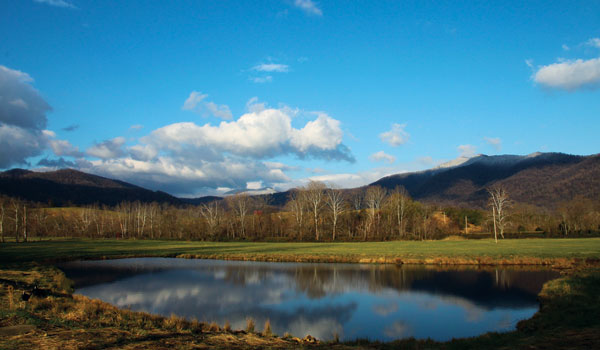
Photo by Doug Dear
On an April afternoon, my husband, Pete, and I head west in traffic during a downpour. But the next morning dawns clear and cool, with mist curling through the valley below our cozy hilltop yurt. As the primary accommodation at Rose River Farm, the yurt is far more luxurious than its name suggests, featuring 17-foot ceilings and leather furniture. I want to savor my coffee and the gorgeous view from our porch, but my guide awaits. I make a mental note to book the place on another occasion for a writing retreat.
With its pastoral setting and stocked stream, the 200-acre farm—which also produces grass-fed Angus beef and peaches—is an ideal place to cast your first line. The Rose River springs up just south of Hawksbill Mountain, the highest point in Shenandoah National Park, and winds for nearly nine miles (roughly a mile and a half through the farm).
Doug Dear, a former investment banker from Northern Virginia and now a private investor who owns the farm, describes the main attraction as “Western-style” fly-fishing, meaning it’s easy to wade into the river’s freestone bottom without muddying the waters and spooking the fish. As a bonus, the stream is also more open than others in the area, so beginners have plenty of room to cast without getting their lines tangled in overhanging trees. (This happens to me only once.)
Before I can begin, I have a few knots to master, including the clinch knot, the double clinch and the surgeon’s knot, which my guide, Gary Burwell, demonstrates with ease. We spend a leisurely 20 minutes practicing tying in a gazebo that overlooks the water. By the end, my fly is knotted to my tippet (a light, nearly invisible piece of line to fool the fish), which is then knotted to my leader (a heavier transitional line), which is knotted to my weighted and colored line.
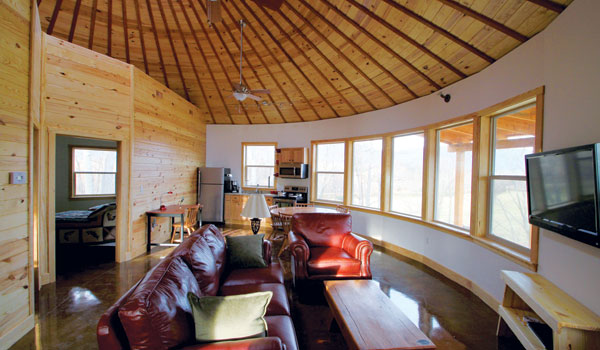
A yurt at Rose River Farm, Photo by Ed Felker
Fly-fishing is so named for the unweighted, manmade lures that—if all goes well—land on the water as lightly as a fly. (Except that the flies in this case are decoys made of feathers, animal hair and beads.) Casting depends on a rhythmic coordination of hand, rod and line.
Although the April air still has a wintry nip, it’s warm in the sun. Small, translucent insects hover above the sparkling water and around the bare trees, giddy with their brief life.
“There’s a bunch of fish rising right here in front of us,” Burwell motions to Pete, eyeing the signs of an active insect “hatch.” Ninety percent of the time trout feed underwater, he explains, but during a hatch, the fish feed on the surface, leaving telltale circles.
Pete picks a Black Caddis fly that resembles the bug that’s hatching this morning and casts nearby, while Burwell steers me toward a farm pond where I can practice.
“The casting motion is like picking up an old-time phone,” he explains. “You want to bend the elbow and try to keep the wrist straight.” To achieve this stance, I’m wearing a wrist brace that attaches my right hand to the rod, so I can’t bend it even if I try. I cast with my right, noting how the rod “loads” with energy as it flexes back and stops, then releases that energy down the line as I move the rod forward.
After an hour of casting practice, I move to a stand of birch trees on the riverbank to try my luck.

Casting for trout, Photo by Ed Felker
Seasoned anglers will tell you there’s a sixth sense to knowing where the wily trout are hiding. In the lingo of the sport, a fly fisherman graciously “presents” his fly to the apparently intelligent fish, which then decides whether or not to strike. I venture into the clear water in borrowed waders and cast across to a deeper spot. With a small amount of weight added to my line, my particular fly—a “wet” fly type known as a Woolly Bugger—is designed to sink and imitate the crayfish below the water.
(Dry flies stay on the surface.)
“This is going to be the hardest part for you to learn,” Burwell says. “Keep your rod tip low, so when that fish hits and you pull back, you have a good chance of setting the hook. You gotta be really quick.”
Apparently, I’m not half bad, because my strike indicator—don’t call it a bobber—soon dips below the surface. Almost instinctively, my finger clamps down on the line, and I pull the rod back to my ear. A moment later, I feel the satisfying tug of a 15-inch rainbow trout tight on my line.
Following Burwell’s instructions, I reel the fish in slow and steady, allowing it to tire itself out from thrashing, and soon it’s in my net. Burwell expertly removes the hook and tells me to wet my hands so I don’t harm the fish.
“Now get him up by the head and back by the tail,” he instructs. The river is catch-and-release, so I bend to submerge my prize, taking a moment to admire the trout’s intricately patterned scales and pinkish streak before setting it free. Holding the fish firmly, I rock it from side to side in the water until it knows up from down. Then there’s a press of raw muscle against my hands, a splash, and it’s gone.
My next score of casts elicit no nibbles and I begin to suspect that the first one was beginner’s luck. “Here’s where the patience and persistence comes in,” Burwell says. “It’s more about aesthetics.”
Four types of trout reside in these waters, according to the Rose River Farm website: wild Rose rainbows, wild brook trout, wild brown trout and stocked jumbo rainbows. Dear stocks the stream in season, from September to mid-June, to keep the levels high, though he inevitably loses some fish to predators, including great blue herons and less-adept fishermen.
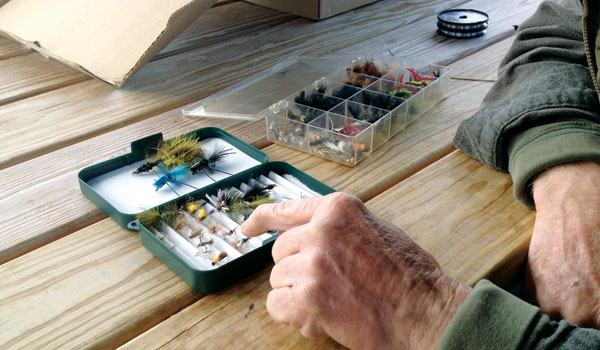
A cornucopia of "flies", Photo by Ed Felker
One of the strategic challenges of fly-fishing is choosing a fly that will prove convincing to the wary fish. Serious fly fishermen often tie their own flies (my dad had his own lap desk for it). Burwell sells his own creations at the farm for about $2 each, including the “Rose River Special”—a Woolly Bugger made with “a gold bead head, light olive body, grizzly hackle and black marabou tail.”
Other flies have equally exotic names, like the Zebra Midge, the Royal Coachman and the Klinkhammer.
For all the colorful flies that exist, I soon realize there are just as many metaphors for fly-fishing itself.
“It’s kind of like playing chess,” says Beau Beasley, a Fairfax County firefighter and author of Fly Fishing the Mid-Atlantic. He’s also the director of the Virginia Fly Fishing and Wine Festival, which takes place in April (www.vaflyfishingfestival.com). “You gotta think a couple steps ahead and try to cast above [the fish] or beside him and get his attention.”
I, for one, have my own analogy. Vinyasa flow yoga, which I practice regularly, is known as “meditation in motion,” and I find that there’s something similarly meditative about the mechanics of fly-fishing. First you cast—backward, forward, backward, forward—so that your line loads and sails. Next, you “mend the line” to get any “belly” (a swell in the wrong direction) out. Then you “strip the line,” gently pulling on it with your free hand so the fly moves through the water, tantalizing your target.
When it’s clear that no self-respecting trout is buying this one, you reel your line in, load your rod and cast again. And again.
Casey Peltier has found a similar tranquility in the rhythms of fly-fishing. “It requires complete concentration and sucks you into it,” says the Falls Church resident, who serves as secretary of the Chesapeake Women Anglers (www.chesapeakewomenanglers.org), an area group that promotes the sport to “lady anglers,” as they’re sometimes known. “It’s a wonderful relaxation,” she says, “because for several hours, all of those cares and concerns are just gone.”
Fly-fishing has even been touted for its healing qualities. Dear is the founding chairman of the board of Project Healing Waters Fly Fishing, a program that advocates fly-fishing as a therapeutic activity for veterans and wounded warriors. The annual “2-Fly Tournament” he’s hosted for the past eight years at Rose River Farm has raised well over $1 million for the cause.
As it turns out, I’m actually pretty good at setting that hook. By the end of the day I’ve caught and released 10 fish, including one “brookie” (the rarer native trout), a feat that warrants bragging rights.
Already setting my sights on my next outing, I’m happy to learn that fly-fishing opportunities are available year-round. Kaitlin Groundwater, who heads the fishing department at the Orvis store in Woodbridge, tell me she fishes for brookies in the Rapidan Wildlife Management Area (located in Madison and Greene counties) in fall and winter. Come summer, she heads to Pohick Bay and Pohick Creek near Lorton to fish for bass and panfish.
Closer to home, Peltier recommends Fletcher’s Cove in Georgetown during the spring shad run, and Riverbend Park in Great Falls for smallmouth bass in August. (Dear closes his farm in the summer, so the fish don’t get stressed by the warmer conditions.)

The writer with her catch
I’m not sure where my next fly-fishing endeavor will take me, but as the saying goes: Trout don’t live in ugly places. I suspect my new hobby will lead me to many sparkling waters.
But for now I will say, “Tight Lines” to you—as many a fly-fishing enthusiast has been known to close his (or her) correspondence.
Amy Brecount White hopes the presentation of her fly will be acceptable to many trout this spring.
IF YOU GO
Rose River Farm (www.roseriverfarm.com) offers fly-fishing for trout at $95 per rod, per day, with groups limited to five rods per day. (Preference is given to those who are also renting a yurt.) Check the farm’s Facebook page for updates on availability, as it tends to book up months in advance.
Reserve Burwell or another guide at the farm (rod price not included) for $80 for a half-day or $180 for a full day (a second person is $130). This includes equipment and ties. The Orvis store in Woodbridge (www.orvis.com/woodbridge) offers day classes ($200 per person) at the farm on April 17 and May 15. (The Orvis store in Clarendon also offers free "Fly Fishing 101"classes closer to home; call store for details.) Virginia requires a valid fishing license (www.dgif.virginia.gov/licenses).
Other nearby activities include horseback riding, hiking, kayaking and vineyard tours. Visit www.madison-va.com and www.virginiawine.org for details.
WHERE TO STAY
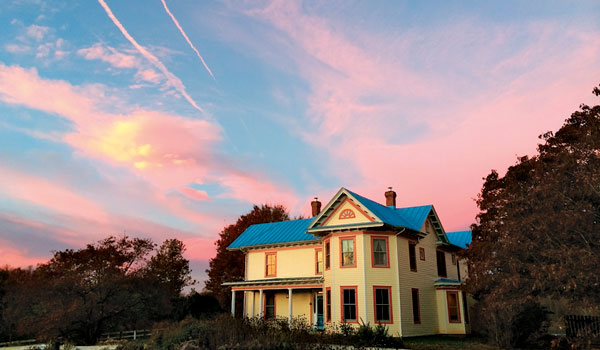
Belle Meade Bed and Breakfast
Rose River Farm maintains three cabins (yurts) on 20 acres across the road from the farm. Surprisingly roomy, each yurt sleeps eight, offering four double beds, a full kitchen, two full baths, a fly-tying desk and use of the pond and surrounding land. Yurt rentals are $250 per night or $1,500 per week.
Graves Mountain Lodge (www.gravesmountain.com), located less than 2 miles from Rose River Farm, offers both motel and cabin lodging, starting at $78 a day per person (double occupancy). Many rates include three hearty country meals, which are served family style in the rustic dining room.
Belle Meade Bed and Breakfast (www.bellemeade.net), roughly 12 miles away in Sperryville, offers rooms and a cabin starting at $160 per night. The B&B has a pool and 138 acres to explore.
WHERE TO EAT
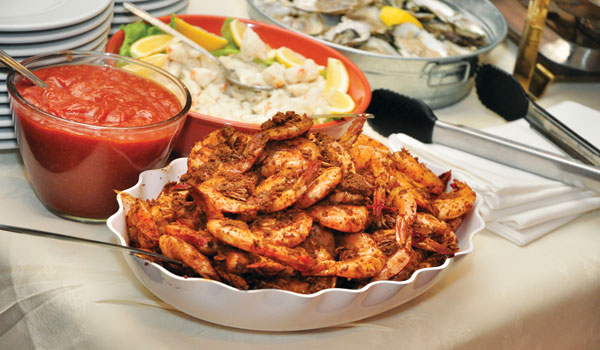
Shrimp at The Copper Fish
Thornton River Grille (www.thorntonrivergrille.com), located about 20 minutes away in Sperryville, offers fine dining in a casual setting with entrées ranging from beef tenderloin to pan-seared scallops.
It’s About Thyme (www.thymeinfo.com), about 20 minutes away in Culpeper, serves dishes ranging from duck paté to pot roast. Its sister restaurant, The Copper Fish, shares the same building and specializes in seafood, including a raw bar.
The Mountaineer Café (540-948-6815, no website) in Madison is ideal for breakfast or a quick bite.
Pie in the Sky (www.pieintheskypizza.com) in Madison offers 36 beers on tap, gourmet pizza, rib-sticking pastas and desserts.
